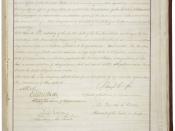Map PresentationIntroductionTeam A has chosen to map the sequence of Confederate States as they returned to the Union. The paper goes on to explain the major points of resistance each of the returning states had to overcome to regain statehood status within the United States.
North Carolina, Tennessee, Missouri, KentuckyNorth Carolina had a long history of slavery and seceded from the union on May 20, 1861. Many North Carolinians, especially yeoman farmers who owned few or no slaves, were not supportive of the Confederacy. Draft-dodging, desertion, and tax evasion were common during the Civil War years (History of North Carolina, 2008). During the civil war, North Carolina suffered heavily from union naval blockades that plugged up all southern ports. North Carolina was finally readmitted to the union on July 4th 1868. North Carolina was required to ratify a new state constitution that It included provisions to establish public education, prohibit slavery, and adopt universal suffrage.
It also provided for orphanages, public charities and a penitentiary. The legislature also ratified the Fourteenth Amendment to the U.S. Constitution (History of North Carolina, 2008). North Carolina received its main form of resistance from the Ku Klux Klan. When the governor of North Carolina used his civil powers to try to combat the Ku Klux Klan, he was impeached and removed from office (History of North Carolina, 2008). White Democrats eventually gained control of the states again and tried to re-establish white supremacy.
Tennessee was the battlefield for a large portion of the Civil War, and was the last state to withdraw from the Union and the first state to be re-admitted on July 24th 1866 (History of Tennessee, 2008). After the war, Tennessee adopted a constitutional amendment forbidding property in men February 22, 1865 and ratified the Fourteenth Amendment to the United States Constitution. It did not have a military governor during reconstruction (History of Tennessee, 2008). Many citizens did not accept the outcome of the civil war, and in the 1970s many whites worked to regain power. They used paramilitary groups to terrorize blacks and their allies and suppress voting (History of Tennessee, 2008). The white, elite-dominated legislature thus had the power to add more Jim Crow laws and establish state segregation with provisions that would last until the mid-20th century (History of Tennessee, 2008).
Missouri in the Civil War was a border state that sent men, generals, and supplies to both opposing sides, had its star on both flags, had state governments representing each side, and endured a neighbor-against-neighbor intrastate war within the larger national war (Missouri in the civil war, 2008). By the time the civil war was over, Missouri had sent 110,000 troops to the union and only 40,000 to the confederacy. Since Missouri never technically left the union, it was spared a lot of the bad parts of reconstruction. Democrats returned to power in 1873 and helped give rise to the sympathetic views of the James-Younger Gang, who were vehemently opposed to the union (Missouri in the civil war, 2008).
Kentucky was neutral in the civil war until a new legislature took power in 1861, and had strong union sympathies (History of Kentucky, 2008). Southern sympathizers attempted to establish an alternative state government with the goal of secession but failed to displace the legitimate government in Frankfort, Kentucky was constantly being pulled between Union and Confederate interests (History of Kentucky, 2008). After the war, the Ku Klux Klan was quite active in Kentucky. Between 1867 and 1881, the Frankfort Weekly Commonwealth newspaper reported 115 incidents of shooting, lynching, and whipping of blacks (History of Kentucky, 2008). Reconstruction also helped establish movements favoring equal citizenship rights for blacks and women.
Florida, South Carolina and MississippiFlorida seceded from the Union Jan. 10 1861, South Carolina Dec. 20, 1860 and Mississippi on Jan. 9, 1861. Their readmission to the Union was made conditional on their adoption of new constitutions acceptable to Congress. When they ratified the constitution and accepted the Fourteenth Amendment to the Constitution of the United States, guaranteeing civil rights for blacks, they were readmitted to the Union. Florida was readmitted on June 25, 1868, South Carolina July 9, 1868 and Mississippi on Feb. 23, 1870..
Alabama, Georgia, and LouisianaThe Fourteenth Amendment was a key issue in Louisiana, Alabama and Georgia's resistance to rejoining the Union. Only one state, Tennessee was in agreement to ratify the Fourteenth Amendment in and therefore Congress allowed them to be readmitted into the Union in 1866. However, 10 other states, including Alabama, Louisiana and Georgia were not willing to ratify the Fourteenth Amendment and were not readmitted at that time. These states were not in favor of a number of conditions of the Fourteenth Amendment. For one, they were not willing to accept section one which "defined an American citizen as anyone born in the United States or naturalized, thereby automatically making an African-American a citizen" (Davidson, 2002). In fact, not until after the ten unreconstructed states were placed under military rule, under the first "Reconstruction Act in March 1867" (Davidson, 2002) would Congress even consider them for re-admittance. As Congress continued to apply pressure using the Union's military in the south to push the Reconstruction and limit the power of military commanders to hold office while giving more rights to black members. The fourth Reconstruction Act removed the need for registered voters to consent and allowed the majority to ratify the Reconstruction.
Once Congress accepted that these conditions were met, in June 1868 they readmitted seven states including Louisiana on July 9, 1868 and Alabama four days later. Georgia was also readmitted, however; Congress shortly rescinded there admission after learning Georgia's State Legislature "expelled twenty-eight black members and seated some former Confederate leaders" (Tindal, 1999). Georgia was then faced with having to re-seat the black members, which was done under military commanders, as well as ratifying the Fifteenth Amendment before they were allowed to be readmitted on July 15, 1870.
Texas, Virginia, ArkansasTexas rejoined the Union on March 30, 2007. The Union required Texas to "have a constitutional convention, with delegates elected by all male citizens over the age of twenty-one, regardless of race, color, or "previous condition of servitude." The convention was to write a new state constitution that would provide for universal adult male suffrage" (Texas State Historical Association, 2003). Texas also had to ratify the Fourteenth Amendment of the United States Constitution in order to be readmitted. The convention met at Austin in June 1868 and did not adjourn until February 1869. In February 1870 the Legislature adopted the Fourteenth and Fifteenth amendments and select United States senators in preparation for readmission to the Union.
Virginia was readmitted to the Union on January 26, 1870. Like many of the other readmitted States, Virginia has to ratify the 14th Amendment of their constitutions and to adopt the 14th and 15th amendments of the United States. Virginia also agreed that their Legislature agree to never amend their state constitution to deny the Negro the right of suffrage, the right to hold office, or their educational privileges.
Arkansas was readmitted to the Union on June 22, 1868. In order to be readmitted, Arkansas also has to agree to ratify the 14th Amendment and draft a new constitution that guaranteed the blacks right to vote.
ConclusionIn Conclusion,team C has successfully mapped the re-admittance of the Confederate states to the Union. On July 26, 1866 Tennessee became the first state that had seceded, to reenter the Union. On June 22, 1868 Arkansas became the second state to be readmitted. In July of 1870 Georgia became the last state to rejoin the Union.
Reference:Barney, William L. (2004). Confederate States of America Page. Retrieved April 25, 2008, from The Secession of the Southern States Web site: http://www.civilwarhome.com/southernseccession.htmDavidson (2002). Nation of Nations (3rd ed.). The McGraw-Hill.
History of Kentucky Retrieved April 28, 2008, from Wikipedia Web site: http://en.wikipedia.org/wiki/History_of_KentuckyHistory of Tennessee. Retrieved April 28, 2008, from Wikipedia Web site: http://en.wikipedia.org/wiki/History_of_TennesseeMissouri in the civil war. Retrieved April 28, 2008, from Wikipedia Web site: http://en.wikipedia.org/wiki/Missouri_in_the_American_Civil_WarTindall, George B. (1999). America: A Narrative History (5th ed.). W.W. Norton Company: New York.
Texas State Historical Association. (2003). Congressional Reconstruction Ends as Texas Readmitted to Union. Retrieved April 27, 2008 from http://www.tshaonline.org/daybyday/03-30-004.html





